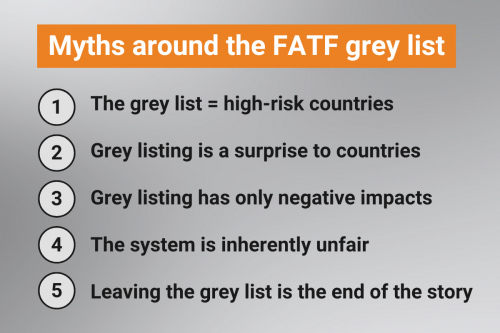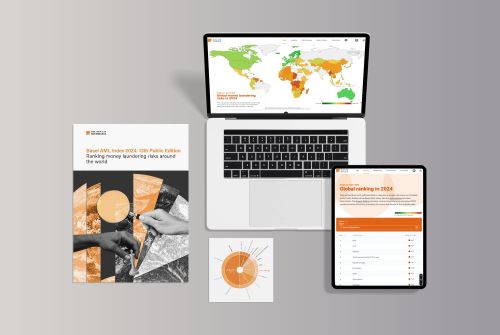Russia’s money laundering risks – what does the latest FATF report mean in practice?

Russia’s risk level in the Basel AML Index has hit a record low following a December 2019 Financial Action Task Force (FATF) assessment that rated the country’s anti-money laundering and counter terrorist financing (AML/CFT) systems as reasonably effective.
The Basel AML Index is the only independent, data-based index of the risk of money laundering and terrorist financing (ML/TF) around the world. Russia’s overall risk score has fallen from 5.75 to 5.60 out of 10, where 10 equals the highest assessed risk of ML/TF. It remains in the medium/high-risk category, reflecting in particular its vulnerabilities to a high level of corruption and to political and legal risks.
The next Expert Edition update of the Basel AML Index will reflect these changes. The Public Edition, which is released annually, will be updated in mid-summer.
Any indications of progress in tackling money laundering and terrorist financing are welcome. However, policymakers and analysts will need to take into account features of the FATF methodology and other factors that may influence a country's ML/TF risk rating before drawing conclusions.
Russia’s case illustrates why, when it comes to combating corruption and money laundering, nobody should take numbers at face value.
Russia’s latest FATF assessment
FATF Mutual Evaluation Reports (MERs) are a primary data source of the Basel AML Index. They assess the quality of a country’s AML/CFT systems (according to 40 Recommendations) and their effectiveness in practice (according to 11 Immediate Outcomes, or IOs).
In the new MER published in December 2019, Russia scores an average of 58 percent across the effectiveness criteria. The highest level of compliance is in IO6 and IO9, relating to the use of financial intelligence information and the investigation and prosecution of TF offences.
The average level of effectiveness shown by all 91 countries assessed with the current (fourth-round) FATF methodology so far is around 30 percent. This puts Russia among the top six countries in terms of effectiveness, after the UK, Israel, the US, Spain and Italy. The results of its neighbours in the region are lower: Ukraine scores 36 percent, Moldova 39 percent, Armenia percent and Belarus 45 percent.
In terms of technical compliance with the 40 Recommendations, Russia scores 68 percent, which is around average.
Why the surprise?
This relatively positive assessment of the effectiveness of Russia’s AML/CFT systems has raised eyebrows among AML experts, including Ellen Timmer, Koos Couvée, and Joshua Kirschenbaum and Jennifer DeNardis.
Is this the same Russia that has featured prominently in recent money laundering schemes and scandals including Danske Bank, Swedbank, ABLV Bank, and the “Troika Laundromat”?
Richard Gordon, director of the Financial Integrity Institute at Case Western University, stated that on this FATF assessment of Russia, “It feels wrong, but, as you start to go through the methodology, it makes more sense.”
Tight state control
The FATF assessment framework does not consider the independence of the judiciary system in the country or the level of political centralisation, political rights and property rights. The consequence is that countries with tight state control tend to demonstrate a relatively high level of performance in the effectiveness of their AML/CFT systems. Recent examples include Chinese Taipei (55%), Cuba (48%), Macao (45%), and Russia (58%).
In a recent paper on “Russian kleptocracy and the rule of law: how the kremlin undermines European judicial systems”, Dr Andrew Foxall argues that the current Russian administration exercises political control over the domestic judiciary. Echoing this, Mr. Gordon states that the Russians “have got a pretty authoritarian operation and so the fact that Rosfinmonitoring [Russia’s Financial Intelligence Unit] is very good is not a surprise – when it’s looking at the people the government really wants to know about”.
In such a situation, the country’s high level of performance in IO6 (on the use of financial intelligence for ML/TF investigations) does not look surprising.
Too much emphasis on TF convictions?
According to the FATF assessment, Russia has a robust legal framework for combatting TF. The executive summary states that “[on] average, Russia pursues 52 TF prosecutions per year. Since 2012, Russia has convicted more than 300 individuals of TF, with the majority resulting in sentences of imprisonment ranging from 3-8 years”.
These numbers in TF prosecutions are very high in comparison to other countries.
- In the US, which was assessed in 2016, the MER speaks of 120 convictions for TF offences in five years, so 26 convictions annually.
- According to the UK’s MER in 2018, it had 103 convictions for TF offences from 2014 to 2017.
- Australia’s MER in 2018 describes only three convictions for TF offences.
- Canada’s MER in 2016 says the country has secured only two convictions.
The number of convictions for TF offences also looks disproportionally high in comparison to the data for real terrorist incidents collected by Global Change Data Lab. Data for 2017 shows 122 incidents in the UK, 65 incidents in the USA, 22 incidents in Russia, 12 incidents in Canada and four incidents in Australia.
This high level of effectiveness in one particular area may skew the overall results.
AML risk is not just about systems
While assessing a country’s ML/TF risks, it is important to consider not just its systems and their effectiveness, but other factors. These include the level of corruption and bribery in the country, the independence of its judicial system, and levels of public accountability, political transparency and media freedom.
While the Basel AML Index places a high emphasis on FATF data, its composite methodology attempts to offer a more holistic picture of a country’s risk exposure to ML/TF by including data on a country’s performance in the above areas.
Media reports are a problematic data source
FATF evaluations are based on an assessment of recent developments in a country in the area of AML/CFT. Some of the media reports on ML scandals associated with Russia happened several years ago and were only discovered and reported on recently. They therefore do not take account of more recent developments in a country’s systems.
This time lag makes it difficult, if not irresponsible, to use case-based data on money laundering in objective evaluations of country risk.
An additional factor is that once a country is labelled a high-risk jurisdiction on the basis of its involvement in a ML scandal in the media, it is not possible for it to demonstrate progress in this area.
Decision-making needs a variety of assessments
When taking a business or policy decision based on a country’s assessed ML/TF risk, it is important to use as many relevant sources of information as possible.
A key additional source is the International Monetary Fund (IMF)’s Country Report. The latest IMF Country Report 19/260 for Russia notes that supervision and AML/CFT regulations “have been improved”. Like the FATF, the IMF positively evaluated the role of Rosfinmonitoring in the area of AML/CFT. It points out, however, several deficiencies related to Know your Customer/Customer Due Diligence (KYC/CDD), the timely reporting of Suspicious Transaction Reports (STRs) and the identification of ultimate beneficial owners.
Another useful source of data on ML/TF risks is a country’s internal reports. Russia’s National AML Risk Assessment in 2017 showed a generally high level of awareness of the country’s ML/TF risks. The report identified main areas of concerns, including budget spending and taxes, corruption, fraud and drug trafficking.
The long view: assessing a country’s risk over time
Every year, the Basel AML Index emphasises the need to assess countries’ AML/CFT risk levels over a long period rather than making a judgement based on a snapshot in time. Zooming out on the history of FATF evaluations on Russia gives us a clearer perspective on Russia’s efforts to combat ML/TF over the past two decades.
View the chart of Russia's performance in the Basel AML Index since 2012.
From 2000 until 2003, the FATF listed Russia as a non-cooperative jurisdiction. Its AML/CFT defences were evaluated as poor by international standards, in particular relating to the absence of comprehensive customer identification requirements; a lack of a suspicious transaction reporting system; and shortcomings in having an operational Financial Intelligence Unit. Russia was removed from the list in 2003, based on the progress it made, and became a full member of the FATF.
In 2008, the Russian Federation was placed in the FATF’s follow-up process as a result of non-compliant (NC) and partially compliant (PC) ratings for certain core and key Recommendations in its MER of June 2008.
From 2008 to 2013, Russia had six follow-up reports. In October 2013, the FATF recognised that the Russian Federation had made significant progress in addressing the deficiencies identified in the 2008 MER and removed the country from the regular follow-up process. The country’s main achievements included:
- Enhancing corporate transparency by introducing beneficial ownership requirements in its AML/CFT legislation.
- Prohibiting credit institutions from opening and maintaining anonymous accounts.
- Addressing certain shortcomings in the criminalisation of terrorist financing and the reporting of shortcomings concerning terrorist financing.
- Strengthening measures to freeze terrorist assets domestically or at the request of other countries.
Other articles you might like:
- What can we learn from recent money laundering cases?
- Money laundering risks in post-Soviet countries: what does the Basel AML Index reveal?
- AML risks in Pakistan: consequences of the latest FATF report
- How can Estonia have the lowest risk of money laundering in the Basel AML Index?
- Basel AML Index 2019: Too little progress – are AML systems effective?
Photo by Pixabay from Pexels.




